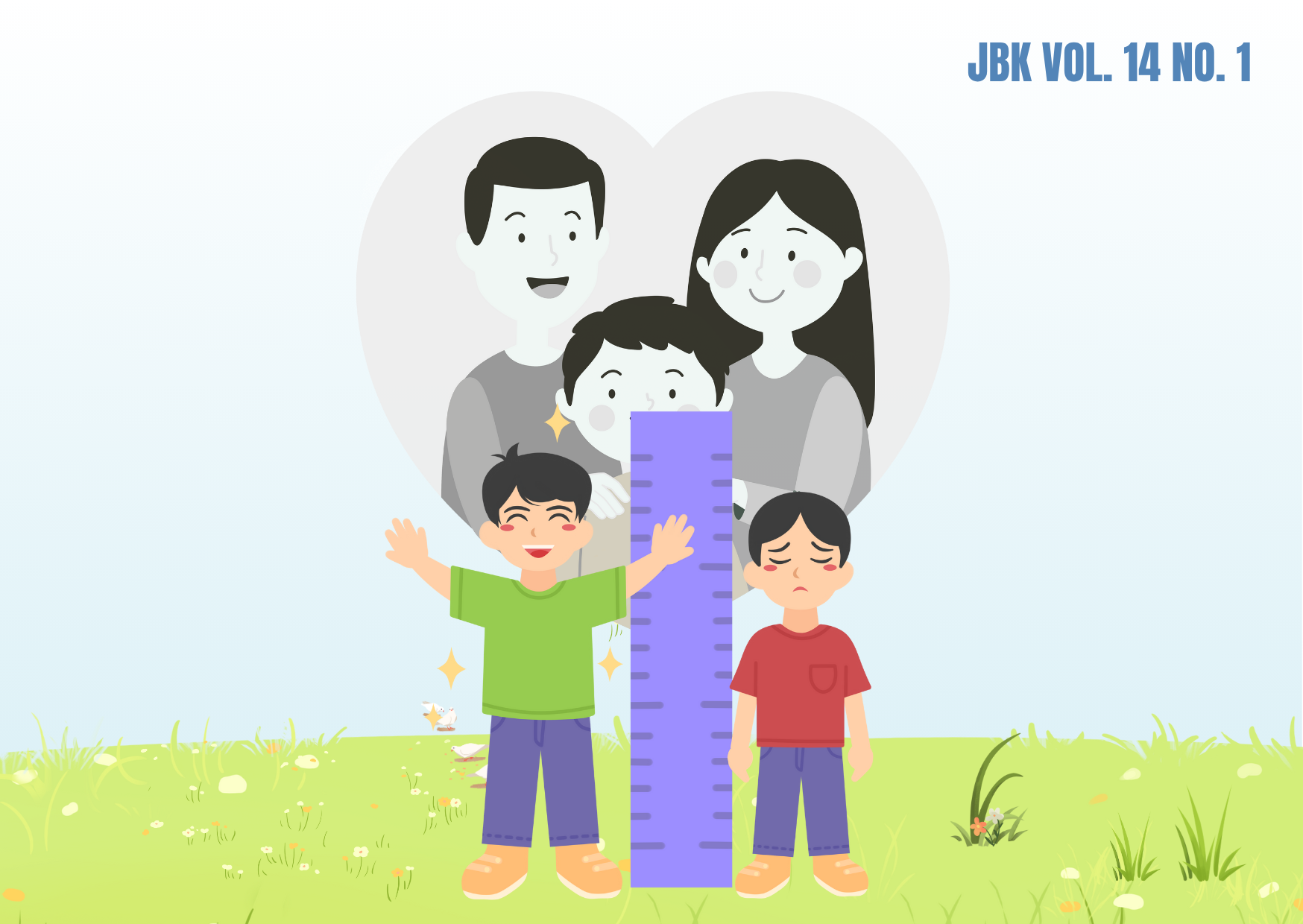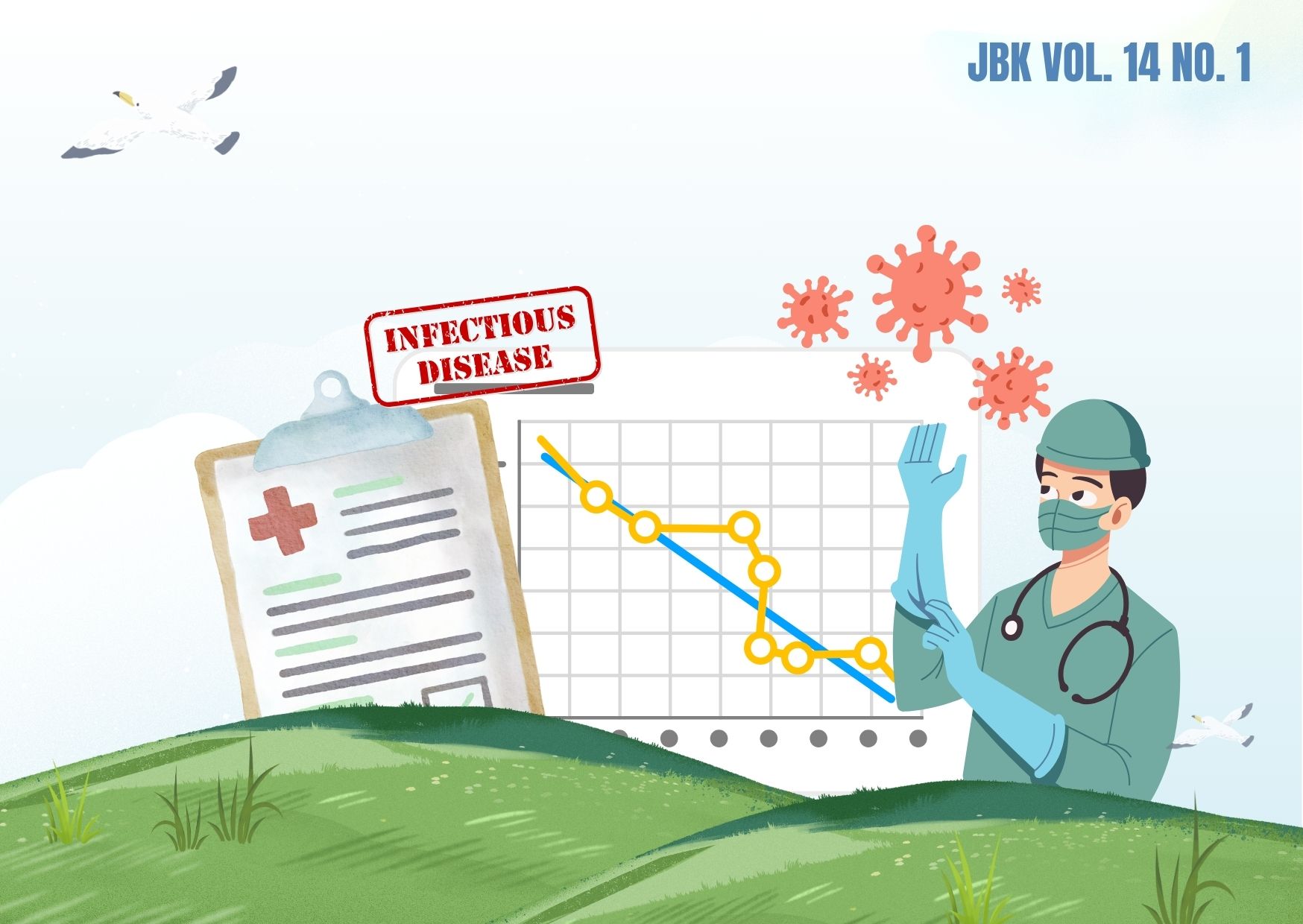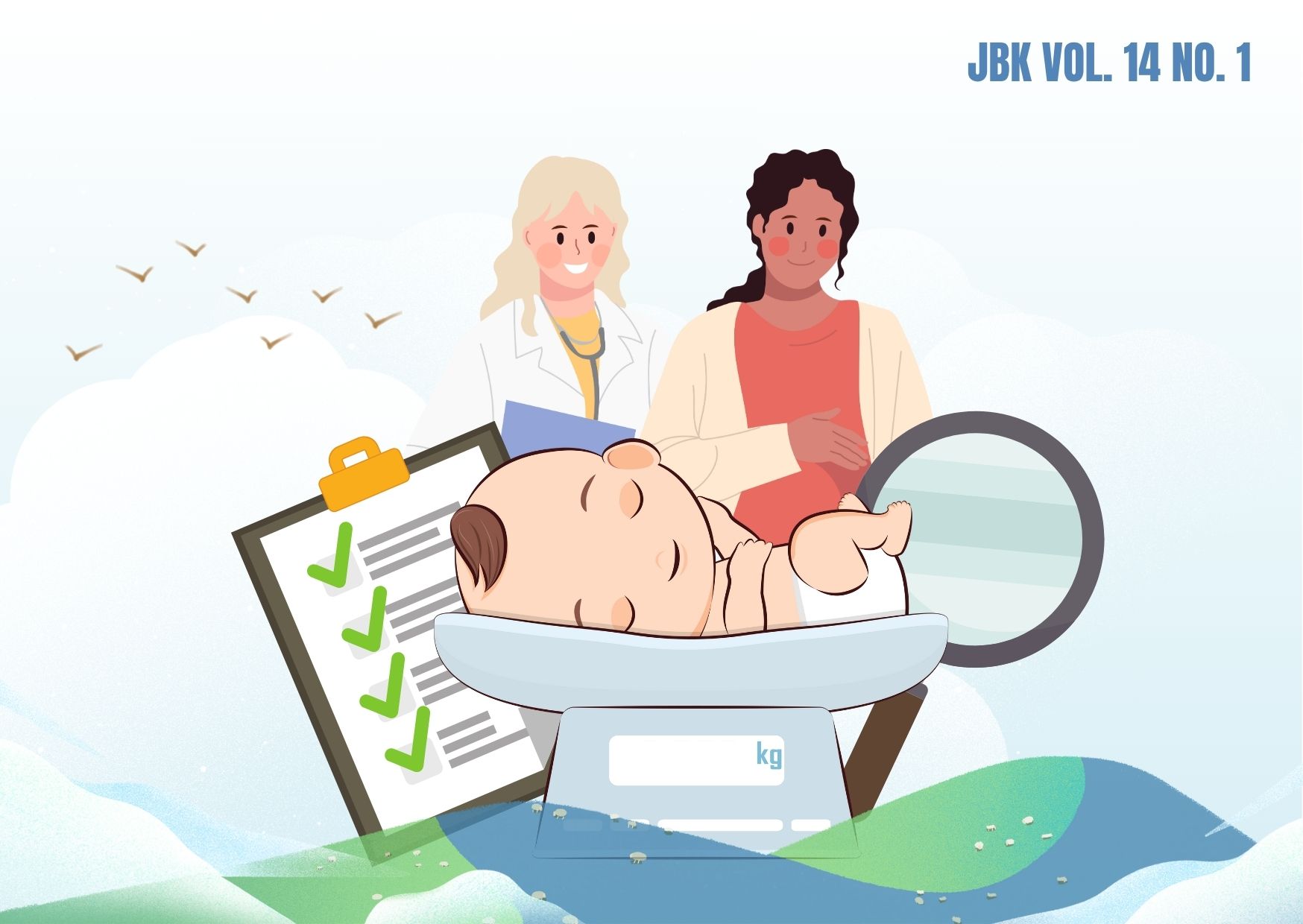ANALYSIS OF PREGNANCY INTENSION RISK FACTORS IN INDONESIA WITH DEMOGRAPHIC HEALTH SURVEY (DHS) IN 2017
Downloads
The pregnancy intention can be divided into two, namely the desired pregnancy and unwanted pregnancy/Kehamilan Tidak Diinginkan (KTD). Unwanted pregnancy can cause negative impacts on the mother, such as not carrying out antenatal care (ANC) and abortion. Besides, babies born from KTD are more at risk of experiencing low birth weight and not getting breast milk/Air Susu Ibu (ASI) from their mothers. Therefore, the risk factors of pregnancy intention need to be known to prevent the incidence of KTD in Indonesia. This study analyzes the risk factors for pregnancy intention in Indonesia, such as maternal age, parity, sex of the baby born, mother's work status, education level, type of area of residence, family economy, and history of contraceptive use or family planning/Keluarga Berencana (KB). The research design was cross-sectional with analysis using logistic regression statistical tests. This study used secondary data from the 2017 Demographic Health Survey (DHS) with 14,778 subjects. The results of this analysis are the risk factors for pregnancy intention in Indonesia, namely the age of the mother (p-value = 0,000 and OR = 1.403), parity (p-value = 0,000 and OR = 2,860), the type of area of residence (p-value = 0,000 and OR = 1,518) and history of use of family planning (p-value = 0.000 and OR = 0.711). The risk of adverse events is greater in mothers aged <20 years and> 35 years, parity more than 3, residing in urban areas, and having a history of using family planning. There is no significant relationship between the sex of the baby, the mother's employment status, education level, and family economy on pregnancy intention.
Afkhamzadeh, A., Rahmani, K., Felehgary, M., Farhadifar, F. and Faraji, O., 2020. Risk Factors for Unintended Pregnancy in Women: A Nested Case-Control Study. Shiraz E Medical Journal, 21 (1), pp. 1-8.
Amalia, EH and Azinar, M., 2017. Unwanted Pregnancy in Adolescents. Higeia, 1 (1), pp. 1-7.
Anggraini, K., Wratsangka, R., Bantas, K. and Fikawati, S., 2018. Factors Associated with Unwanted Pregnancy in Indonesia. PROMOTIVE: Journal of Public Health, 8 (1), pp. 27–37.
APJII, 2017. Internet User Behavior & Penetration in Indonesia Survey 2017.
Apriliana, AK, Maftuchah and Nurhudhariani, R., 2016. The Relationship of Education and Parity with the Incidence of Unwanted Pregnancy at Family Planning Acceptors at PKBI As Sakinah, Pemalang Regency, 2014. Journal of Midwifery SMART, 3 (2), pp. 36–45.
Aryati, S., Sukamdi, S. and Widyastuti, D., 2019. Factors Affecting the Selection of Contraception Methods (Case in Seberang Ulu I District, Palembang City). Indonesian Geography Magazine, 33 (1), pp. 79–85.
Asiah, 2009. Relationship between Education Level and Reproductive Health Knowledge for Housewives in Rukoh Village, Syiah Kuala District, Banda Aceh. Journal of Educational Biology, 1 (2), pp. 1–4.
National Population and Family Planning Agency, 2013. Indonesian Demographic and Health Survey 2012. Jakarta.
National Population and Family Planning Agency, 2018. Indonesian Demographic and Health Survey 2017. Jakarta.
Bearak, J., Popinchalk, A., Alkema, L. and Sedgh, G., 2018. Articles Global, Regional, and Subregional Trends in Unintended Pregnancy and Its Outcomes from 1990 to 2014: Estimates from A Bayesian Hierarchical Model. The Lancet Global Health, 6, pp. 380–389.
Bellizzi, S., Mannava, P., Nagai, M. and Sobel, HL, 2020. Reasons For Discontinuation of Contraception Among Women With A Current Unintended Pregnancy in 36 Low and Middle-Income Countries. Contraception, 101 (1), pp. 26–33.
BPS, 2019. National Socio-Economic Survey (SUSENAS) - Socio-Culture and Education Module (Annual), 2018.
Buttaro, TM, Bailey, PP, Cook, JS and Trybulski, J., 2019. Primary Care: Interprofessional Collaborative Practice. 6th ed. Missouri: Elsevier.
Cheraghi, P., Poorolajal, J., Moeini, B. and Cheraghi, Z., 2013. Predictors of Unintended Pregnancy Among Married Women in Hamadan, Western Iran: A Case-Control Study. Iranian Journal of Public Health, 42 (8), pp. 854–859.
Dini, LI, Riono, P. and Sulistiyowati, N., 2016. The Effect of Unwanted Pregnancy Status on Mother Behavior During Pregnancy and After Birth in Indonesia (2012 IDHS Data Analysis). Journal of Reproductive Health, 7 (2), pp. 119–133.
Dixit, P., Ram, F. and Dwivedi, LK, 2012. Determinants of Unwanted Pregnancies in India Using Matched Case-Control Designs. BMC Pregnancy and Childbirth, 12 (84), pp. 1–12.
Exavery, A., Kanté, AM, Njozi, M., Tani, K., Doctor, HV, Hingora, A. and Phillips, JF, 2014. Predictors of Mistimed and Unwanted Pregnancies among Women of Childbearing Age in Rufiji, Kilombero, and Ulanga Districts of Tanzania. Reproductive Health, 11 (63), pp. 1–9.
Finer, LB, and Zolna, MR, 2011. Unintended Pregnancy in The United States: Incidence and Disparities, 2006. Contraception, 84 (5), pp.478–485.
Ganatra, B., Gerdts, C., Rossier, C., Johnson, BR, Tunçalp, Ö., Assifi, A., Sedgh, G., Singh, S., Bankole, A., Popinchalk, A., Bearak , J., Kang, Z. and Alkema, L., 2017. Global, Regional, and Subregional Classification of Abortions By Safety, 2010–14: Estimates From A Bayesian Hierarchical Model. The Lancet, 390 (10110), pp. 2372–2381.
Gustikawati, N., Wulandari, LPL, Duarsa, DP, Gustikawati, N., Wulandari, LPL and Duarsa, DP, 2014. Inhibiting and Supporting Factors for the Use of Implant Contraceptives in Puskesmas I Denpasar Utara. Public Health and Preventive Medicine Archive, 2 (2), pp. 181–188.
Harianti, R. and Nurbaiti, 2016. Characteristics, knowledge, and attitudes of fertile aged couples about Indragiri Hulu Regency. Journal of Reproductive Health, 7 (3), pp. 1999–209.
Hidayati, DS, 2014. Psychological Background of Anxiety in Pregnant Women Age 35 Years and Over. Scientific Journal of Applied Psychology, 02 (02), pp. 325–334.
Ikamari, L., Izugbara, C. and Ochako, R., 2013. Prevalence and Determinants of Unintended Pregnancy Among Women in Nairobi, Kenya. BMC Pregnancy and Childbirth, 13 (69), pp. 1–9.
Ismiati, 2014. The Use of the Internet on Adolescent Knowledge in Preventing Unwanted Pregnancy. Journal of Health Media, 7 (1), pp. 31–36.
Indonesian Ministry of Health, 2013. Health Data and Information Window Bulletin. Ministry of Health of the Republic of Indonesia. Jakarta.
Khayati, YN and Sundari, S., 2019. The Relationship between Birth Weight and Growth and Development. Indonesian Journal of Midwifery (IJM), 2 (2), pp. 58–63.
Kurniasari, D. and Arifandini, F., 2015. Relationship between Age, Parity and Diabetes Mellitus in Pregnancy with the Incidence of Preeclampsia in Pregnant Women in the Work Area of Puskesmas Rumbia, Central Lampung Regency, 2014. Journal of Holistic Health, 9 (3), pp. 142 –150.
Kusmanto, TY, 2013. Those Who Are Uprooted From Their Future: Sociological Analysis of Child Social Problems in Indonesia. Sawwa: Journal of Gender Studies, 8 (2), p. 225.
Kusumawati, D., Kurniawati, I. and Pratiwi, AY, 2018. Relationship between Frequency Parity and Selection of Long-Term Contraception Methods in Fertile Women Ages 15-49 Years at Bpm Ny.D Singotrunan Village, Banyuwangi Regency, 2018. Healthy, 7 (1 ), pp. 1-10.
Lusiana, N., Andriyani, R. and Megasari, M., 2015. Textbook of Midwifery Research Methodology. Yogyakarta:Deepublish.
Magowan, BA, Owen, P. and Thomson, A. eds., 2014. Clinical Obstetrics and Gynecology E-Book. 3rd ed. Edinburgh: Saunders Elsevier.
Mardjan, H., 2016. The Effect of Anxiety on Adolescent Primiparous Pregnancy. Jakarta: Abrori Institute.
Mohamed, EA-EB, Hamed, AF, Yousef, FMA and Ahmed, EA, 2019. Prevalence, Determinants, and Outcomes of Unintended Pregnancy in Sohag District, Egypt. Journal of the Egyptian Public Health Association, 94 (14), pp. 1–9.
Nawati and Nurhayati, F., 2018. Impact of Unwanted Pregnancy on Pregnancy and Infant Care (Phenomenology Study) in Bogor City. Journal of Health, 9 (1), pp. 21–25.
Nurcahyani, DA and Trihandini, I., 2013. Unwanted Pregnancy and Baby Birth Weight. National Journal of Public Health, 7 (8), pp. 354–359.
Minister of Workers Regulation No. 3 of 1989 concerning the Prohibition of Termination of Employment (PHK) for female workers due to marriage, pregnancy, or childbirth.
Pratama, C., 2017. Value of Children in Indigenous Culture: The Existence of Boys in the Komering Tribe Family. An Nisa'a: Kanian Journal of Gender and Children, 12 (1), pp. 89–98.
Putri, CYYP, 2014. The Relationship between Perceptions of Children's Values and the Number and Sex of Children Desired in Premarital Women in Rural Areas. Journal of Biometrics and Population, 3 (1), pp. 20–27.
Rizkah, Z. and Mahmudiono, T., 2017. The Relationship Between Age, Gravida, and Work Status Against the Risk of Chronic Energy Deficiency (KEK) and Anemia in Pregnant Women. Amerta Nutrition, 1 (2), pp. 72–79.
Saptarini, I. and Suparni, 2016. Determinants of Unwanted Pregnancy in Indonesia (Secondary Data Analysis Riskesdas 2013). Journal of Reproductive Health, 7 (1), pp. 15–24.
Saputra, W. and Munandar, B., 2018. The decision to Have Children for Migrant Residents in Slum Settlements in Palembang City, South Sumatra Province. Demography Journal of Sriwijaya, 2 (1), pp. 25–39.
Sari, IP, Suroyo, RB and Fitria, A., 2019. Analysis of Determinant Factors of Mother's Behavior in Pregnancy on Baby Weight at the Simeulue Regional General Hospital in 2018. Journal of Issues in Midwifery, 3 (3), pp. 97– 119.
Say, L., Chou, D., Gemmill, A., Tunçalp, Ö., Moller, AB, Daniels, J., Gülmezoglu, AM, Temmerman, M. and Alkema, L., 2014. Global Causes of Maternal Death: A WHO Systematic Analysis. The Lancet Global Health, 2, pp. 323–333.
Sedgh, G., Bearak, J., Singh, S., Bankole, A., Popinchalk, A., Ganatra, B., Rossier, C., Gerdts, C., Tuncalp, O., Johnson Jr, BR, Johnston, HB and Alkema, L., 2016. Abortion Incidence Between 1990 and 2014: Global, Regional, and Subregional Levels and Trends. Lancet, 388 (10041), pp. 258–267.
Singh, S., Shekhar, C., Acharya, R., Moore, AM, Stillman, M., Pradhan, MR, Frost, JJ, Sahoo, H., Alagarajan, M., Hussain, R., Sundaram, A., Vlassoff, M., Kalyanwala, S. and Browne, A., 2018. The Incidence of Abortion and Unintended Pregnancy in India, 2015. The Lancet Global Health, 6 (1), pp.e111 – e120.
Siregar, SMF and Elida, S., 2020. Factor Analysis of Mothers Who Have Normal Childbirth Experiencing the Risk of Caesarean Section. Journal of Midwifery Maternity, 4 (2).
Sumartini, S. and Indriani, D., 2017. The influence of the desire of fertile age couples (Pus) in long-term contraceptive methods. Journal of Biometrics and Population, 5 (1), pp. 27–34.
Umaroh, AK, Kusumawati, Y. and Kasjono, HS, 2017. The Relationship Between Internal and External Factors and Adolescent Premarital Sexual Behavior in Indonesia. Andalas Public Health Journal, 10 (1), pp. 65–75.
Law of the Republic of Indonesia Number 36 of 2009 concerning Health.
UU no. 13 of 2003 concerning Manpower.
Yazdkhasti, M., Pourreza, A., Pirak, A. and Abdi, F., 2015. Unintended Pregnancy and Its Adverse Social and Economic Consequences On Health System: A Narrative Review Article. Iranian Journal of Public Health, 44 (1), pp. 12–21.
Zulkifli, Amri, and Munawar, E., 2020. Fertility Analysis in Aceh Province. Darussalam Journal of Economic Perspectives, 6 (1), pp. 54–71.
Copyright©2022 Jurnal Biometrika dan Kependudukan (Journal of Biometrics and Population)
This work is licensed under a Creative Commons Attribution-NonCommercial-ShareAlike 4.0 International License.
1. Copyright of all journal manuscripts is held by the Jurnal Biometrika dan Kependudukan.
2. Formal legal provisions to access digital articles of the electronic journals are subject to the provision of the Creative Commons Attribution-ShareAlike license (CC BY-NC-SA), which means that Jurnal Kesehatan Biometrika dan Kependudukan to keep, transfer media/format, manage in the form of databases, maintain, and publish articles.
3. Published manuscripts both printed and electronic are open access for educational, research, and library purposes. Additionally, the editorial board is not responsible for any violations of copyright law.



































